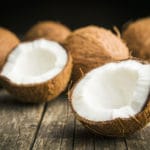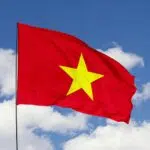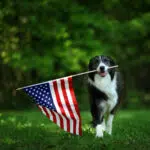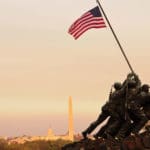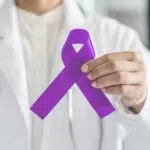V-J Day, celebrated every September 2 in the U.S., stands for Victory over Japan Day, commemorating a shift in the Second World War in favor of the Allies (the U.S., Great Britain, France and other nations) that spelled the end of the massive conflict. It is commonly accepted knowledge that what precipitated the Japanese Empire’s ultimate surrender was the U.S. having bombed two major Japanese cities (Nagasaki and Hiroshima) with atomic warheads, causing such a concentrated and gigantic loss of Japanese lives that there really was no hope of a victory for the island nation thereafter.
When is VJ Day 2024?
America’s victory over Japan in the Second World War is celebrated on VJ Day on September 2.
History of VJ Day
In much the same way as a statement like, “I’m not a hero, I just did what anyone would have done,” has come to sound trite, we’re sure that in the mid-20th century, the phrase “ultimate sacrifice” held a power that was more raw and personal than it may hold now. Americans had seen nothing like it. The First World War was, until that point, considered “the war to end all wars,” but in terms of death tolls, WWII saw the demise of around three times more than its predecessor (50-80 million souls lost in WWII, around three percent of the world population).This is to say that the average Joe or Jane back then was indeed spontaneously overcome with joy and emotion on the day of declared victory, even to the point where some of the V-J Day celebrations around the world resembled riots, and cost lives in their own right. However, the nation and the western world were united. Good had triumphed over evil.Today, the History Channel and other popular TV broadcasting, plus many Hollywood films, and a ton of printed fiction and nonfiction popular literature, all still frequently feature the events of the European and Pacific Theaters of WWII as story material. We think it’s a safe assumption that our readers have a basic working knowledge of the United States’ entry into the war following the kamikaze Japanese (conventional explosive) bombing of Pearl Harbor, forward in time through the American landing on the beaches of Europe, sacrificing life and limb to fetter the Nazi animal and gradually gaining more ground, on through to the bitter end.The iconic images, too, are unforgettable. The famous scene of a sailor sweeping a Navy nurse into his arms and kissing her during the Times Square public celebration of V-J Day, as it happens, is actually two very similar photographs taken of the same couple by two different photographers who had their work published in two different national periodicals. More on that shortly. For now, though, let us all agree that the celebration of V-J Day every September 2 is not a thing to be taken lightly, considering the true costs of war, and yet it should be a source of positive pride and the relief brought by the end of a trying labor, passed down through generations.
VJ Day timeline
The United States abandons any attitude of 'wait and see' regarding the then-foreign war, when Japanese fighters and other craft attack the U.S. naval base at Pearl Harbor, Hawaii without warning.
Emperor Hirohito announces to the Japanese people his administration’s intention surrender to the Allies.
Japanese Foreign Minister Mamoru Shigemitsu and General Yoshijiro Umezu, on board the American warship the U.S.S. Missouri, sign the Potsdam Declaration, a document of surrender that the Allies had drawn up.
48 countries sign, including Japan and the vast preponderance of Allied nations, officially ending World War II.
Traditions of the Day
When World War 2 ended, millions of people participated in street parties and parades. Soldiers and other stationed personnel climbed traffic-light poles and paper was thrown like confetti from buildings. Many jovial grand celebrations took place. Today, the celebrations aren’t as jubilant but still quite zealously patriotic. The day is enjoyed with friends and family including good food and drink. Many World War II-centered Hollywood movies and documentaries are broadcast on T.V. and opinions and other write-ups are featured in print media. Tributes and memorials are paid to everyone who lost their lives to the War. V-J Day is also a time to learn about the events of World War II from all sides and reflect on them so that history never repeats itself.
By The Numbers
3 P.M. – the number of waves in which the attack by Japan on Pearl Harbor was executed.
33% – the number of planes in the first wave of the attack.
10 – he number of planes in the second wave of the attack.
17 – the number of Americans who died during the attack on Pearl Harbor.
½ – the number of ships that sank during the attack on Pearl Harbor.
51% – the year when the first atomic bomb was dropped on Hiroshima, Japan.
65% – the estimated number of people killed in the bombings on Hiroshima and Nagasaki.
VJ Day FAQs
So that’s V-J Day, what about V-E Day, when did that happen?
On May 8, 1945, the Allies accepted the unconditional surrender of Nazi Germany, a mere eight days after Adolf Hitler’s suicide. The signing marked “Victory in Europe Day,” or V-E Day as we’ve come to know it.
If the United States entered a war “already in progress,” how long did American soldiers fight before the Allies’ final victory?
Pearl Harbor was bombed on December 7, 1941, and U.S. troops, sailors, Marines and pilots fought from then till three years, eight months, and seven days later when V-J Day was official on September 2, 1945.
What was the Japanese Emperor’s on-the-record comment, upon his nation’s surrender?
Hirohito said of the atom bomb and its power that if his country continued to fight, “it would not only result in the ultimate collapse and obliteration of the Japanese nation, but would also lead to the total extinction of human civilization.”
How to Observe VJ Day
-
Visit the graves of the fallen
Many communities have cemeteries with designated areas for military veterans. Many of these men and women fought in World War II, so you can pay your respects with a visit and a moment of prayer, reflection or silence. You may even look up how to volunteer to place flags on military graves in honor of service done to our country.
-
Learn what led up to the war
In "The Tempest," Shakespeare wrote that "what's past is prologue." Another way of saying, “If you don’t know where you’ve been, you don’t know where you’re going.” So we think it’s a good idea to carry national and worldwide memories in our hearts as individuals, so that no matter how complicated politics becomes, we know where our hearts lie, and how to further the best agenda moving forward.
-
Talk to a veteran
Many members of "The Greatest Generation" who fought in World War II are still living, though their numbers are dwindling rather rapidly. Ask around, and see if you can schedule a visit, perhaps to a home-care facility or VFW lodge. Chances are, a WWII veteran will be as glad to tell his or her story as you are to listen!
Five Incredible Facts About V-J Day’s Aftermath
-
Binocular Vision?
The famous “Kiss” photograph was actually two similar shots of the same moment, as we mentioned above: one printed in the New York Times and credited to Navy photog Victor Jorgensen, and the other published in Life magazine courtesy of lensman Alfred Eisenstaedt. Over the years, many men and women have claimed to be the couple in the photo, to varying degrees of plausibility.
-
One official and one unofficial commemorative date
The bombing of Hiroshima and Nagasaki led to about more than 200,000 casualties.
-
A huge price to pay
In the days following the Japanese surrender, scores of Japanese soldiers took their own lives, unable to live with the shame of being beaten in war, and nearly 100 American prisoners in Japanese custody were murdered outright.
-
Back to the status quo
Although the officials of the island of Hong Kong dubbed the end of the war their “Liberation Day” from fascist forces, Hong Kong was simply handed back over to the British Royal Navy, once again becoming a British dependency.
-
Tiny and alone
Over 77 years after the famous day, the only state in the United States to recognize V-J Day as an official holiday is Rhode Island, where it’s celebrated yearly on the second Monday in August. In the 70s it was renamed simply “Victory Day” to remove any implication that its celebration would be due in any part to gloating over the loss of Japanese lives.
Why VJ Day is Important
-
It marked the end of years of nearly incomprehensible losses of life and property.
World War II was the deadliest conflict in human history, involving over two dozen countries, and the casualty totals remain mind-boggling: upwards of 80 million people killed in violent action. The end of hostilities meant that war-torn peoples and nations could exhale a collective sigh of relief.
-
It led to the rebuilding of Europe and Japan.
In 1948, partially to pre-empt the spread of Communism in Europe but mainly to aid the reconstruction of European and Pacific-region infrastructure and economies, the U.S. enacted the Marshall Plan, which infused friendly nations overseas with about 12 billion dollars in aid (128 billion in today’s dollars).
-
It inspires us to seek peace
As we mentioned, the First World War was called "the war to end all wars,” but in the century since then of near-continuous fighting, including World War II, Korea, Vietnam, and the Middle East operations, has unfortunately turned that phrase on its head. If anything though, the pervasiveness of armed conflict itself can help us appreciate the moments when our world is at relative calm and peace.
VJ Day dates
| Year | Date | Day |
|---|---|---|
| 2023 | September 2 | Saturday |
| 2024 | September 2 | Monday |
| 2025 | September 2 | Tuesday |
| 2026 | September 2 | Wednesday |
| 2027 | September 2 | Thursday |

